 Degenerative joint disease, or Osteoarthritis, usually occurs after years of wear and tear on the joints but can in fact, affect a dog or cat of any age. Large dogs are most vulnerable but feline pals too can feel the pain. It can affect one or more joints and is found in one out of five dogs at some point during their lifetime.
Degenerative joint disease, or Osteoarthritis, usually occurs after years of wear and tear on the joints but can in fact, affect a dog or cat of any age. Large dogs are most vulnerable but feline pals too can feel the pain. It can affect one or more joints and is found in one out of five dogs at some point during their lifetime.
As pets and people age, cartilage in the joints begins to thin. Cartilage is the cushion that protects the bones in the joint. Without that cushion, friction occurs as bones rub against each other, wearing down causing pain and loss of mobility. Inflammation in the joint capsule can also lead to bony growths, known as spurs, which too make movement painful. Any joint in your cat or dog’s body can be affected by osteoarthritis, but the most common locations are the hips, elbows, knees, wrists, shoulders, ankles, and lower back.
Arthritis can be passed down through the genes, something none of us can prevent, but just because a pet is more at risk of developing a condition, doesn’t mean he has to acquire it! Dogs however, who are genetically disposed to hip dysplasia may experience accompanying arthritis. Other causes and risk-factors that contribute to arthritis, that you can help your dog or cat avoid are obesity, poor nutrition, lack of exercise, and injuries to the joints (i.e. cruciate ligament injuries, patellar luxations).
Signs & Symptoms of Arthritis in your dog or cat:
- Pet is less active or appears tired. Pet owners often dismiss these signs as their dog “just getting older,” but the pet may actually be in pain. This is particularly common with cats.
- Limping, which may appear better as the pet “warms up” throughout the day.
- Pain or difficulty getting up. Flopping when laying down. Both often accompanied by moaning or groaning.
- Labored, stiff movements. Joints no longer bend easily.
- Pet appears to have a stiff neck or hunches his back, possibly attributable to arthritis in the spine.
- Dog is irritable. Pain makes the best of us grouchy!
- Muscles atrophy, tissue dies off, due to decreased use.
- Pet may lick, chew or bite at limb trying to alleviate pain
- Since it may hurt your pet to get into the appropriate #2 squat position, he may not go and this may back his system up resulting in constipation but the underlying cause may be arthritis pain.
How to Help a Dog with Arthritis:
Your first stop is at your veterinarian’s office for an exam and possibly x-rays. Once you have a diagnosis, the goal of treatment prescribed will be to control the dog’s pain level and increase his movement and function. Unfortunately, there currently is no cure for osteoarthritis however, attempts can be made to slow down the degeneration of the joint and repair cartilage.
There are several medications that your veterinarian may prescribe:
Pain relievers, such as non-steroidal anti-inflammatory drugs (NSAIDS) like Rimadyl, reduce inflammation resulting in less pain, but can have side effects that impact the liver and kidneys. If your dog is prescribed NSAIDS, it is important that your checks your pet’s blood before and while on these medications to ensure his organs aren’t compromised.
Gabapentin (also marketed under brand name Neurontin(®)) is an anticonvulsant and pain relief medicine intended for the relief of neuropathy (nerve pain). It produces its effects by inhibiting the release of a type of neurotransmitter known as “glutamate” but can cause deficiencies in calcium, vitamin D, vitamin B1 and folate. Vitamins D and B1 are required for nerve repair, so be sure to give your dog a high quality multivitamin.
Cortisone or steroids can also combat inflammation, but since they suppress the immune system, can lead to serious side effects from slow wound healing, hair loss, UTIs, increased chances of diabetes, muscle weakness and more.
Chondroprotectants, such as Adequan, inhibit the enzymes that contribute to cartilage breakdown, protecting the cartilage as it tries to repair itself.
Keep in mind that many drugs meant for humans can be toxic to dogs, so never treat your pet with medication from the pain relief aisle in your local drugstore without consulting your veterinarian.
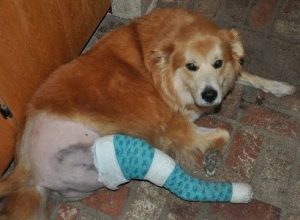
Some dogs are great candidates for surgery which can range from cleaning out debris inside the joint to replacing the joint with an artificial one.
Additionally, there are many complementary controls you can initiate to help alleviate arthritis pain in your dog, or maybe even prevent the onset. Acupuncture, underwater treadmill therapy and Low Level Light or “cold laser” therapy may be used to stimulate healing, reduce inflammation and provide pain relief. Benefits may include stimulation of both cartilage and collagen.
Weight Control
Obesity is linked to the severity of arthritis and the onset of its symptoms. Keeping your dog at a healthy weight alleviates stress on joints. Most pets and people actually do best a tad on the leaner side rather than when overweight, so keeping your dog fit can potentially prevent wear and tear on joints in the first place.
Nutrition
Proper nutrition can add years to your pet’s life and delay the need for osteoarthritis medications however, no one diet is perfect for every dog, so speak with a professional to customize your dog’s best diet.
Feed your dog high quality lean protein, most of which should come from beef, poultry, and fish. Eggs and cheese are also good protein sources. Amino acids from protein may help alleviate arthritis associated symptoms.
Too many carbohydrates can lead to weight gain, so limiting carbs is important when structuring an arthritis diet for dogs. Grains, starches, and nightshade vegetables (bell peppers, eggplant, potatoes, tomatoes) all contribute to inflammation. Rice, wheat, corn and barley can cause swelling, as well as fluctuations in your dog’s blood sugar levels.
Fats are the richest source of calories, so you must carefully monitor your dog’s fat intake to keep his weight in check. Feed your dog lean meats and fish, lower in Omega-6s but higher in omega-3 fatty acids.
Vitamin D helps the body absorb calcium and aids in bone growth and strength. Dairy products, especially cottage cheese, fish, beef, liver and egg yolks are all rich in Vitamin D. Calcium can build and maintain strong bones but can assist the central nervous system and major organs. Sardines with bones are a great source of calcium for dogs, but give dairy in small amounts. It is vital to any arthritis diet for your dog that you balance calcium with Vitamin D intake, as lack of calcium with increased “D” will cause your dog’s body to draw calcium from his bones!
Magnesium regulates blood sugar levels, helping muscles and nerves function, and plays a crucial role in protein synthesis. It is also needed because it allows your dog’s body to absorb calcium. Meat, beans, bananas and leafy vegetables are good sources of magnesium.
In 2018, researchers at Cornell University concluded a double-blind study on the effects of CBD oil on dogs suffering from osteoarthritis. Over the course of six weeks, dogs were given either CBD oil or an oral placebo, two times daily. Dogs who took the CBD oil showed clear improvement with veterinarians noting a decrease in pain and an increase in activity with no reported side effects.
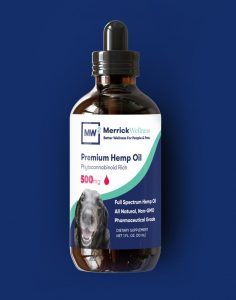
CBD is an acronym for Cannabidiol (Can-a-bid-i-ol), a naturally occurring class of molecules called cannabinoids abundant in the plant genus Cannabis Sativa L. CBD makes up close to 40% of the plant and is just one of over 80 cannabinoids presently identified in cannabis sativa. CBD interacts with an animal’s naturally occurring endocannabinoid system (more about this under “How does it work?”), and is non-psychoactive because there is little to no THC (tetrahydrocannabinol). In brief, CBD rich sativa plants having low levels of THC are referred to as Hemp and Marijuana plants are those with high levels of THC. Speak with your dog’s veterinarian about whether CBD by Merrick Wellness could benefit your best friend.
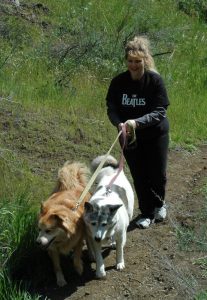 Exercise
Exercise
We all need our joints to work smoothly and efficiently to get us where we want to go. Moderate exercise can keep movement fluid, slow deterioration and minimize pain.
Exercise may benefit your dog by lowering risks of arthritis, diabetes and other health related issues.
Stretching before and after exercise can be of prime importance. The Hip Flexors are the muscles that allow your dog to move his legs and hips. With your dog standing, hold his back leg above his knee and gently stretch it straight back behind his body. When you reach a point of resistance, hold the position 15 – 30 seconds. Repeat 2 – 3 times with each back leg.
This stretch can increase flexibility in your dog’s hips and spine while strengthening his lower back, hip and leg muscles. It may also lessen arthritis pain.
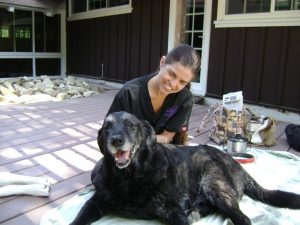
Massage
Massage is the manipulation, methodical pressure, friction and kneading of the skin, muscle and soft tissues to achieve specific therapeutic results. Massage alleviates some of the pain and stiffness that comes with chronic arthritis by increasing the flow of blood, nutrients and oxygen to all the tissues of the body. Injuries can be prevented by giving massage prior to heavy exercise and allowing your dog to warm-up and cool-down when participating in any type of sporting activity. An added plus is that massage can create a deeper bond between you and your dog.
At Home Tools
Make sure your dog’s bed is made of material he doesn’t sink into too deeply making it difficult to get up and out of. Beds should be made of orthopedic or egg-crate foam and placed in a dry, draft-free location where pets can feel part of the family.
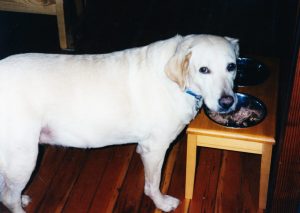 Raise feeding bowls so that larger dogs don’t have to bend. Many have aching shoulders because as their hind-quarters weaken, more stress is placed on the front parts of their bodies, so not having to lower their head can alleviate pain.
Raise feeding bowls so that larger dogs don’t have to bend. Many have aching shoulders because as their hind-quarters weaken, more stress is placed on the front parts of their bodies, so not having to lower their head can alleviate pain.

Provide ramps to make stair climbing easier. Placing an ottoman or bench seat under a sill will allow your smaller canine to comfortably peak out his favorite window let your canine buddy climb onto the sofa or bed to snuggle with you.
Slinging a towel under his hind quarters (behind his belly) or purchasing specialized slings like the Gingerlead Harness will allow you to assist your dog as he keeps those paw moving taking pressure of sore hind joints.
The important part of any illness, injury or disease, is that you manage pain by keeping your veterinarian, your dog’s second best friend, well informed, and…spend quality time together.









